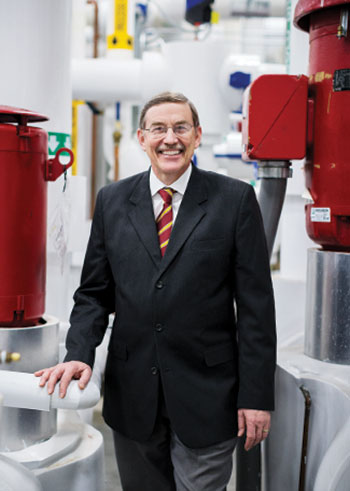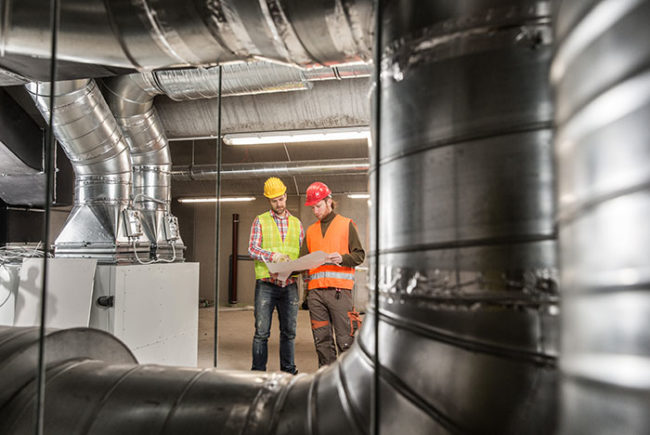 |
PHOTO BY SARA RUBINSTEINThe Hermans FileCV Accomplishments Education |
Richard D. Hermans, PE, HFDP, director of training and advanced applications for Daikin Applied, Minneapolis, talks about the evolution of hospital airflow standards as well as the key role he’s played in developing the American Society of Heating, Refrigerating and Air-Conditioning Engineers ventilation standards and their incorporation into the Facility Guidelines Institute’s Guidelines for Design and Construction of Hospitals and Outpatient Facilities.
What was the idea behind the first health care facility ventilation standards and when were they written?
The Hill-Burton Act of 1947 was the first that had some thought put into their creation. It established requirements for utility, toilets, bedpans, baths, sterilizers, kitchens, morgues and laundry rooms. The only patient spaces that had requirements were operating and delivery rooms. The requirements for these spaces included the need for humidification to prevent sparks and 100 percent outdoor air to control the flammable anesthetics.
When you edited the American Society of Heating, Refrigerating and Air-Conditioning Engineers (ASHRAE) Handbook chapter on health care in the late 1980s, you were charged with finding the source material for all of the ventilation standards in effect at that time. What did you learn about their origins?
The 1978 edition of the handbook chapter suffered from editing that reduced the page count, and the references went from 42 to 10. My task was to find all the old research reports that supported the handbook. I discovered that a lot of the old research that established the need for good air quality was conducted using real patients in pretty poor hospital settings. That research probably couldn’t go on today. The 1978 edition was remarkable because, for the first time, the ventilation rates between ASHRAE and the precursor to the Facility Guidelines Institute’s (FGI’s) Guidelines for Design and Construction of Hospitals and Outpatient Facilities were not the same. The handbook kept rates as they had been since 1968, but the Guidelines reduced rates.
What is the relationship between the ASHRAE HVAC Design Manual for Hospitals and Clinics and ASHRAE Standard 170?
ASHRAE was receiving requests for a health care design manual prior to 1996. That year, ASHRAE approved the creation of a special project to write an HVAC design manual. As the manual was being developed, it became apparent that it could unintentionally become a de facto standard and code. Only Standard 62.1 had any American National Standards Institute (ANSI) ventilation requirements. So, it was determined by agreement between the Standard 62.1 project committee and the 9.8 technical committee that a new ANSI standard on health care ventilation was needed. I was honored to chair the committee that wrote the standard. The first edition of the HVAC Design Manual was published in 2003 and Standard 170, Ventilation of Health Care Facilities, was released in 2008. Both have since been revised in second editions.
How did Standard 170 become part of the FGI Guidelines?
It never would have happened without the efforts of the chairman of the Health Guidelines Revision Committee, Doug Erickson. He led the effort to bring common sense and reason to the confusion of multiple ventilation tables. After the 2008 edition of Standard 170 was published, FGI and ASHRAE entered into a Memorandum of Understanding to republish the standard as part of the 2010 edition of the Guidelines. The ventilation rate tables were removed from the Guidelines and reference was made to Standard 170 for direction on ventilation design. Today, the Standard 170 committee includes members of the Health Guidelines Revision Committee, the body responsible for updating the content of the Guidelines, and works closely with them to maintain a coordinated set of requirements.
What roles did ASHRAE and the American Society for Healthcare Engineering (ASHE) play in making that a reality?
ASHRAE saw an opportunity to fulfill its mission of advancing the art and science of HVAC and refrigeration, so their decision to accept the proposal from ASHE and FGI was an easy one. ASHE has had a long-standing joint sponsorship agreement on the development of ASHRAE/ASHE Standard 170 and was very open to the concept of incorporating the standard into the Guidelines. ASHE played a major role in the development of the 2010 Guidelines and became the publisher of the Guidelines beginning with that edition. ASHE has been very supportive of a close relationship with ASHRAE and there are many active volunteers who are members of both organizations.
Do you think the role of ventilation in infection control and energy savings is appreciated?
The connection between ventilation and the safety of patients and staff is not well-understood in my opinion. There are certain aspects of ventilation that have become commonly accepted practice for infection control due to the work done by ASHRAE, FGI, the National Institutes of Health and the Centers for Disease Control and Prevention. These include negative pressure in isolation rooms, positive pressure in operating rooms, positive pressure in protective environment rooms, and filtration requirements for all areas of the hospital. I believe it is incumbent upon organizations to educate administrators on the importance of research based on clinical outcomes to make the ventilation requirements established by code truly accepted minimums.
What important regulatory changes have you seen regarding health care ventilation over the past decade?
Certainly that would be the creation of an ANSI standard for health care ventilation. That alone has brought organization to the system of ventilation codes and standards. When FGI adopted Standard 170, there were fewer conflicts in determining the standard of care in design. Now, all the various jurisdictions can point to one source for their regulations. Another important trend in health care ventilation is the understanding that the use of ventilation as a means for infection control depends upon the specific care that is delivered in the space and has nothing to do with the type of building that space is in. An operating room is ventilated the same way whether it is located in a hospital or a clinic.
What are the most important technological changes that you’ve seen over the past several years?
The important technologies developed recently have been in HVAC equipment. Heat recovery devices are making a significant comeback to offset the high ventilation rates in hospitals and clinics. Terminal devices such as fan coils and heat pumps have been improved to be able to accommodate higher filtration requirements. The induction unit has made a surprising comeback in the form of chilled beams. Standard 170 has been changed as needed and where appropriate to accommodate these new technologies.
What do you see for the future of health care ventilation?
Because federal rule changes have altered the health care marketplace and indirectly caused downward pressure on our ventilation requirements, I would like to be able to say that requirement X for ventilation prevents Y hospital-acquired infections each year compared with requirement Z. This would make it possible to offer design teams and hospital owners a performance option for ventilation and they would choose their own level of risk.
Mike Hrickiewicz is editor of Health Facilities Management.





